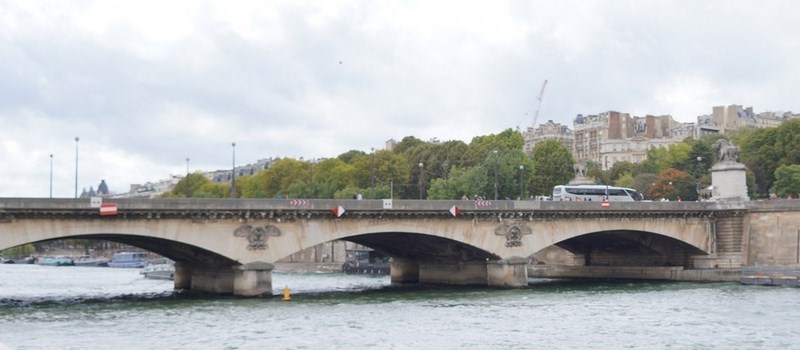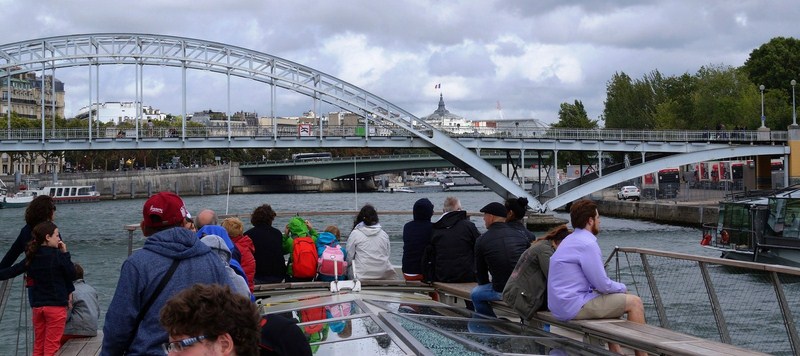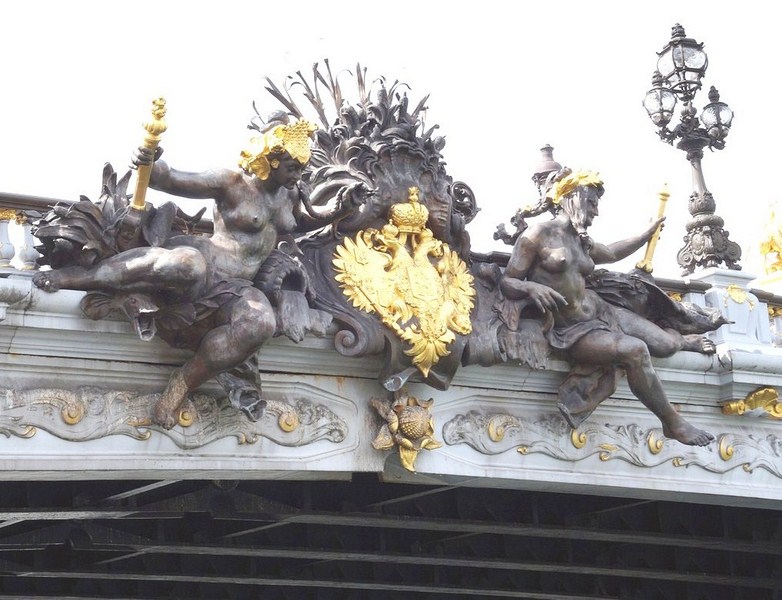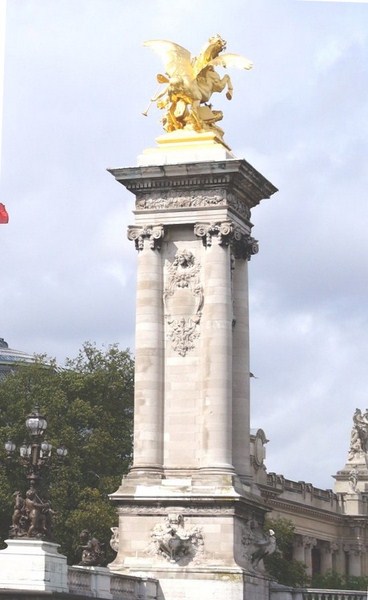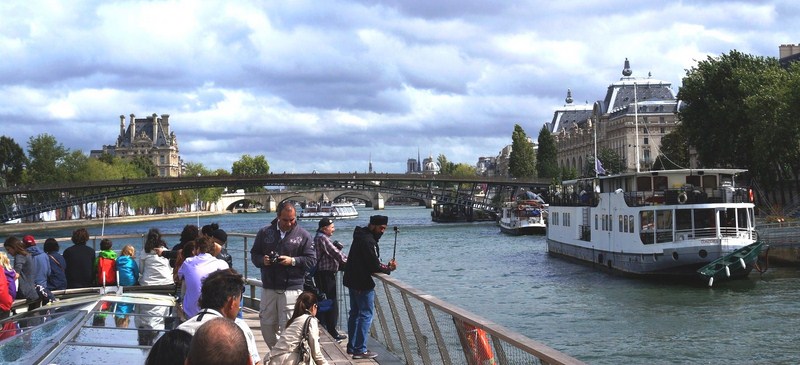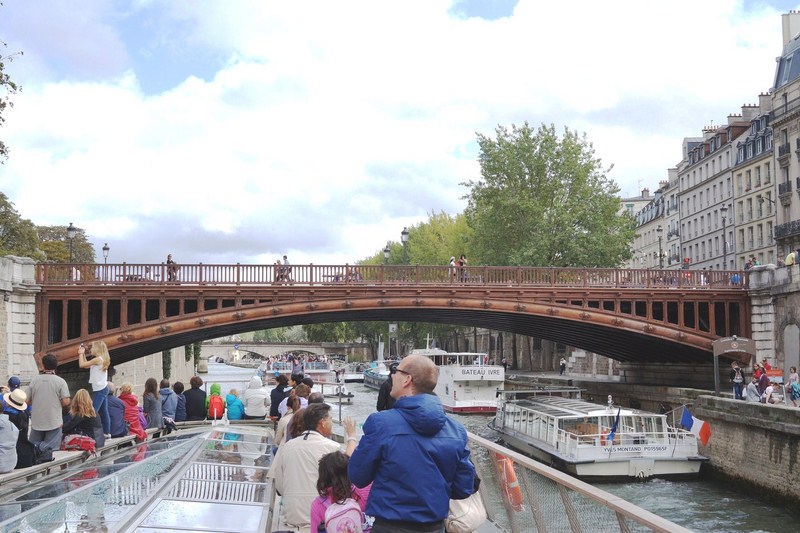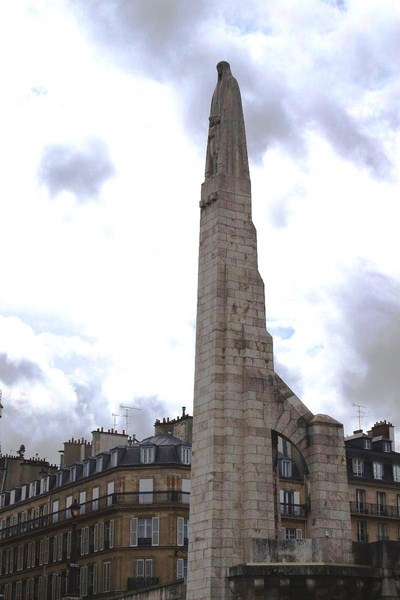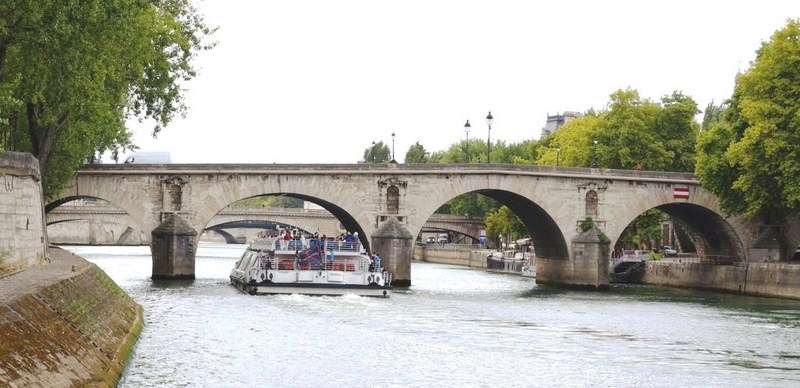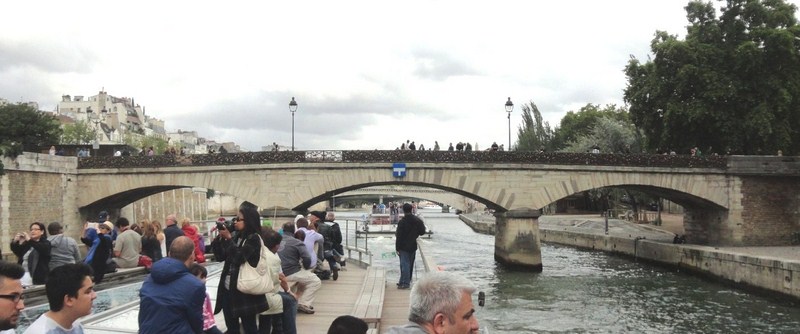During our Seine River Cruise, on board a popular and modern Bateaux Parisiens glass-topped trimaran, we passed by some of the city of Paris’ major bridges and passerelles (pedestrian footbridges). The city has 37 bridges across the River Seine of which 5 are pedestrian, 2 are rail bridges, three link Île Saint-Louis to the rest of Paris, 8 do the same for Île de la Cité and one links the 2 islands to each other. The city’s bridges offered us a lesson in history and architecture. A list follows, from downstream to upstream:
Check out “Seine River Cruise”
The 155 m. long and 35 m. wide Pont d’Iéna (“Jena Bridge”), linking the Eiffel Tower on the Left Bank to the district of Trocadéro on the Right Bank, was built from 1808 to 1814 and designed with five arches, each with an arc length of 28 m., and four intermediate piers.
Check out “Eiffel Tower”
The tympana, along the sides of the bridge, had been originally decorated with imperial eagles conceptualized by François-Frédéric Lemot and sculpted by Jean-François Mouret. Soon after the fall of the First Empire in 1815, the eagles were replaced with the royal letter “L” but, in 1852, when Napoléon III ascended the throne of the Second Empire, , the royal “L” was replaced new imperial eagles sculpted by Antoine-Louis Barye,
Four sculptures, sitting on top of four corresponding pylons on the two ends of the bridge, were put in place in 1853. The sculpture of a Gallic warrior (by Antoine-Augustin Préault) and a Roman warrior (by Louis-Joseph Daumas) are along the Right Bank while the sculpture of an Arab warrior (by Jean-Jacques Feuchère) and a Greek warrior (by François Devault) are along the Left Bank. Since 1975, this bridge has been part of the supplementary registry of historic monuments.
The steps leading off the bridge, popularly known among film fans as the “Renault stairs,” was featured in a scene in A View to a Kill where James Bond (played by Roger Moore) drove a hijacked Renault 11 taxi down the steps in pursuit of an assassin, later revealed to be May Day (Grace Jones).
The 125 m. long and 8 m. wide Passerelle Debilly (Debilly Footbridge), a through arch footbridge, connects the quai de New York to the quai Branly, close to the Eiffel Tower. Opened in 1900, it was designed by architect, Jean Résal (who also designed the Pont Alexandre III) and named after General Jean Louis Debilly of the French First Empire who was killed in the Battle of Jena in 1806.
The footbridge, built on a metallic framework resting on two stone piers at the riverbanks, is decorated with dark green ceramic tiles arranged in a fashion that suggests the impression of waves. In 1966, as a contemporary of the Pont Alexandre III and the Austerlitz Viaduct, the Passerelle Debilly was eventually included in the supplementary registry of historical monuments and, along with the Eiffel Tower, is the second metallic structure that stands as an attestation to the engineering achievements of its epoch. In 1991, the bridge was repainted and, in 1997, its cladding was resurfaced with hard tropical wood. The bridge is located near the Métro station: Iéna.
The 160 m. long and 40 m. wide Alexandre III Bridge (Pont Alexandre III), a deck arch bridge widely regarded as the most ornate, extravagant bridge in the city, connects the Champs-Élysées quarter with those of the Invalides and Eiffel Tower. Since 1975, the bridge has been classified as a French monument historique.
This bridge, with its 32 exuberant Art Nouveau bronze candelabras, cherubs, nymphs and winged horses at either end, was built between 1896 and 1900 and was named after Tsar Alexander III (the second to last emperor of Russia) who, in 1892, concluded the Franco-Russian Alliance. Tsar Nicholas II (his son), Empress Alexandra Fedorovna and French President Felix Faure laid the foundation stone in October 1896. The Beaux-Arts style of the bridge reflects that of the Grand Palais, to which it leads on the right bank.
A marvel of 19th century engineering, the bridge was designed by the architects Joseph Cassien-Bernard and Gaston Cousin, built by engineers Jean Résal and Amédée Alby and was inaugurated in 1900 for the Exposition Universelle (universal exhibition) World’s Fair, as were the nearby Grand Palais and Petit Palais. Consisting of a 6 m. (20 ft.) high single span steel arch, its design was constrained by the need to keep the bridge from obscuring the view of the Champs-Élysées or the Invalides.
Check out “L’Hotel des Invalides”
Sculptures, provided by numerous sculptors, feature prominently on the bridge. Watching over the bridge are four gilt-bronze statues of Fames supported on massive 17 m. (56 ft.) masonry socles, crowned by Fames restraining Pegasus, that provide stabilizing counterweight for the arch, without interfering with monumental views.
The nymph reliefs, at the centers of the arches over the Seine, are memorials to the Franco-Russian Alliance. The Nymphs of the Seine, with a relief of the arms of Paris, faces the Nymphs of the Neva, with the arms of Imperial Russia. Both are executed in hammered copper over forms by Georges Récipon.
The 152 m. long and 18 m. wide Pont des Invalides, the lowest bridge traversing the Seine, was opened in 1855 in time for the upcoming 1855 World Fair in Paris. Paul-Martin Gallocher de Lagalisserie and Jules Savarin used the existing piers of the former suspension bridge (built in 1829) and a newly added central pier to build an arch bridge in masonry on the same site.
The new pier was adorned with sculptures in two allegorical themes – Land Victory by Victor Vilain (upriver) and the Maritime Victory by Georges Diébolt (downstream). The two old piers, adorned with sculptures of military trophies bearing the imperial coat of arms, were both done by Astyanax-Scévola Bosio.
The 106 m. long and 15 m. wide Passerelle Léopold-Sédar-Senghor, a footbridge in the 7th arrondissement of Paris, is served by the Metro station Assemblée Nationale. Formerly known as Passerelle Solférino (or Pont de Solférino), it renamed on October 9, 2006 on the centenary of Léopold Sédar Senghor’s birth. Linking the Musée d’Orsay and the Jardin des Tuileries (Tuileries Gardens), the bridge was built between 1997 and 1999 under the direction of the engineer and architect Marc Mimram.
With a single span and no piers, this architecturally unique metallic bridge is covered in exotic Brazilian ipê wood (also used for outdoor flooring at the Bibliothèque nationale de France) which gives it a light and warm appearance.
Its foundations, at either end, are in the form of concrete pillars extending 15 m. into the ground, and the structure itself is made up of six 15- ton components built by Eiffel Constructions Métalliques, the Eiffel engineering company. For the year 1999, its innovative architecture brought Marc Mimram the award “Prix de l’Équerre d’Argent.” For promenaders, the bridge also has benches and lampposts. They can reach the Jardin des Tuileries through a subterranean passage on the Rive Droite.
The 232 m. long and 22 m. wide Pont Neuf (“New Bridge”), the oldest (built from 1578 to 1607) standing bridge across the river Seine, stands by the western (downstream) point of the Île de la Cité, the island in the middle of the river that was, between 250 and 225 BC, the birthplace of Paris (then known as Lutetia) and, during the medieval period, the heart of the city. Since 1889, it has been listed as a monument historique by the French Ministry of Culture.
The bridge is composed of two separate spans. One, of five arches, joins the left bank to the Île de la Cité. The other, of seven arches, joins the island to the right bank. At the tip of the island is Square du Vert-Galant, a small public park, nicknamed the “Green Gallant,” named in honor of Henry IV. In 1991, it became a UNESCO World Heritage Site. From time immemorial, it has appeared in countless paintings and , on this bridge, one can make out previous water levels that broke the Seine’s banks.
The 45 m. long and 20 m. wide Pont au Double, linking the 4th and 5th arrondissements of Paris, from the Île de la Cité to the quai de Montebello, derives its name from the toll amount which was charged (a “double” denier), money which used to pay for the construction of the bridge. Built in 1883, this one arch cast-iron bridge replaced bridges built from1626 to 1634 (collapsed in 1709, the rebuilt bridge remained in place until 1847).
The 122 m. long and 23 m. wide Pont de la Tournelle (Tournelle Bridge), an arch bridge with a 7 m. clearance above the central arch, was built in 1928. In order to emphasize the shapeless landscape in the part of the Seine that it bestrides, the Pont de la Tournelle was intentionally built lacking symmetry. Its grand central arch, linking the riverbanks via two smaller arches, one on each side, is decorated, on the Eastern bank, with a pylon built on the left pier‘s cutwater.
The statue of Saint Geneviève (the patron saint of Paris), atop of the pylon, was designed by Paul Landowski, a Polish-French monumental sculptor .
The Pont de Sully (or Pont Sully), constructed in 1876 (as part of Haussmann’s renovation of Paris), was designed by the engineers Paul Vaudrey and Gustave Brosselin. Opened on August 25, 1877, it is named after Maximilien de Béthune, Duke of Sully (1560–1641) and minister to Henry IV.
In reality, it is two separate bridges set at an angle of about 45 degrees to the river banks, which means that it gives a splendid view over the quais of the Île Saint-Louis and Notre-Dame. The northern part, over the narrower arm of the river, consists of a central 42-m. arch in cast iron and two 15-m. arches in masonry. It links the island to the rest of the 4th arrondissement on the Right Bank (the nearest Metro station, Sully – Morland, is located here). The southern part, consisting of three cast iron arches, links the island to the Boulevard Saint-Germain in the 5th arrondissement of Paris on the Left Bank.
The 92 m. long and 22 m. wide Pont Marie, linking the Île Saint-Louis to the quai de l’Hôtel de Ville, is one of three bridges designed to allow traffic flow between the Île Saint-Louis and the Left and Right banks of Paris. Linking the Right Bank, the Pont Marie is the counterpart of the Pont de la Tournelle which is built along the same line but serves to connect the Île Saint-Louis with the Left Bank. Started in 1614 and opened in 1635, it was designed by
Rémy Collin, Jean Delgrange, Christophe Marie (after whom the bridge was named after) and reconstructed in 1670. Each of its five arches is unique and the niches in the abutments have never been filled with statues.
The 68 m. long and 17 m. (11 m. usable) wide Pont de l’Archevêché (Archbishop’s Bridge), linking the 4th Arrondissement, at the Île de la Cité, to the 5th Arrondissement (between the quai de Montebello and the quai de la Tournelle), is the narrowest road bridge in Paris. Located near the Métro station: Maubert-Mutualité, It was built in 1828 by the engineer Plouard and is composed of three arches of stone measuring lengths of 15 m. (49 ft.), 17 m. (56 ft.) and 15 m. (49 ft.).
The 67 m. long and 16 m. wide Pont Saint-Louis (3:34 PM), in the 4th arrondissement, links the Île de la Cité (the seventh to link the two islands since 1630) with the Île Saint-Louis. Started in 1969 and inaugurated in 1970, the bridge is served by the Cité stop of the Paris Metro.
Bateaux Parisiens: Pontoon 3, Port de la Bourdonnais, 75007 Paris, France. Tel: +33 825 01 01 01 and +33 1 76 64 14 66. Open 9:30 AM – 10 PM. Website: www.bateauxparisiens.com. Admission: adults (€15), children under 12 yrs. (€7), free for children under 3 years old. Ticket will be valid for one year at any given time. Departures: April to September (from 10:15 AM -10:30 PM, every 30 mins., no departures at 1:30 PM and 7:30 PM), October to March (from 11 AM -8:30 PM, at least every hour). Book online in advance to avoid queues. The boat also departs from Notre Dame Cathedral. Audio guide commentary with musical accompaniment, from a handset, available in 13 languages (English, French, German, Spanish, Italian, Portuguese, American, Russian, Dutch, Polish, Chinese, Japanese and Korean). Smoking is not allowed on the boat and animals are not permitted on board.
How to Get There: Champ de Mars Tour Eiffel (RER C) 5 . Nearest metro: Trocadero or Bir Hakeim


